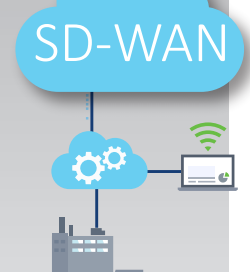An application of software-defined networking (SDN) that is applied to WAN connections and used to connect enterprise locations across vast geographic distances. It connects branch offices, data centers, and other business sites to a central corporate network, using a software approach. This means a network admin can remotely program appliances via a central controller, reducing provisioning times and minimizing the need to manually configure traditional routers in branch locations. Ultimately, this solution aims to move more network control into the cloud.
HOW DOES SD-WAN WORK?
SD-WAN is an overlay technology, meaning it’s not a network in itself. Instead, it sits on top of your network and allows you to prioritize individual applications. There are two ways to deploy: one requires no devices at your location and the other calls for an inexpensive box that powers SD-WAN functions pushed to it from the cloud.
TWO ARCHITECTURE TYPES:
Hybrid
A business has an MPLS circuit in place, but also has public internet. This gives the power back to the branch, allowing you to transport independently so you don’t have to route every piece of traffic over the private network. As a result, non-critical traffic doesn’t bog down the private network.
Dual Internet
Believed to be the future of WAN. It allows for transport independence, cheap circuits, and use of multiple providers in order to use the best path available to get the job done. Adapts to how the network is actually being utilized, making it the most future-proof solution.
WHY DO YOU NEED SD-WAN?
Simply put, SD-WAN allows you to prioritize individual applications and enhance your internet connection. It calls for less time and effort spent towards fixing the WAN because you can correct issues by simply logging into your controller panel, a software-as-a-service (SaaS) application that can be accessed anywhere with an internet connection. You can also manage branches remotely, turn them up and down, and re-prioritize them with ease.
SD-WAN allows you to remotely program network appliances through a centralized software platform, reducing provisioning times.
Also, like MPLS, SD-WAN allows you to apply Quality of Service (QoS) and prioritize data that you send through your network, down to an individual application. This means you can choose to send the traffic that is most important to your business faster than other types. For instance, if clean, clear, and reliable calling and immediate CRM access are most important to your business, you can make voice and your CRM top priorities so a greater portion of your bandwidth is dedicated to sending those apps.
WHAT ARE SD-WAN’S BENEFITS?
- QoS through prioritization of data (voice, video, apps etc.)
- Cost-effective connection of over thousands of branches across a WAN
- Elimination of reliance on dedicated circuits, allowing for flexibility in network choices
- Can deploy new branches 20x faster than MPLS deployments
- A future-proof solution because it adapts to how the network is being utilized
- Reduction of stress on management because of its reliability
- Remote management of branches and other business sites
- Works with any WAN architecture because it’s an overlay technology

